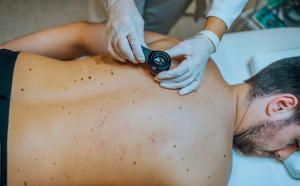What You Can Do to Reduce the Risk of Melanoma

Melanoma is much less common than other types of skin cancer.
However, experts warn that it is more dangerous, as it is more likely to spread to other parts of the body if not discovered and treated in time. Fortunately, there are several ways to reduce your risk.
Our body continuously renews its cells to replace old or dead cells. In some cases, this process can be altered and produce “immortal” cells that build up in the tissues, resulting in tumors.
Tumors can be benign (not cancer) or malignant. In a malignant tumor, harmful cells can spread throughout the body and invade other tissues, a phenomenon known as metastasis. Therefore, cancer is not just one disease, but many.
Causes of melanoma
Melanoma is a type of cancer that is caused by changes or mutations in melanocytes, cells that produce a pigment in the skin called melanin, which is responsible for giving color to your skin and hair. There are four main types of melanoma:
- Superficial spreading melanoma: The most common type. It is usually flat and irregular in shape and color, with variable black and brown shadows. It is more common in people with fair skin.
- Nodular melanoma: Normally starts as a raised area that is blueish-red or dark blackish-blue. Sometimes, it may not have any color (known as amelanotic melanoma).
- Lentigo maligna melanoma: Usually occurs in the elderly. It is most common in sun-damaged skin, primarily on the face, neck, and arms. With this type, abnormal skin areas are usually large, flat, and brown with dark brown areas.
- Acral-lentiginous melanoma: The least common form of melanoma. It generally occurs on the palms of the hands, soles of the feet, and under the nails.
In 2020, there were 324,635 new cases reported along with 57,043 deaths, according to the International Agency for Research on Cancer. Of them, 105,172 cases and 8,412 deaths occurred in North America, whereas 18,881 cases and 5,657 deaths occurred in Central and South America and the Caribbean.
Although the risk of onset of melanoma increases with age, statistics indicate that it is being seen more and more often in young people. Certain factors can indicate a higher risk of developing melanoma, such as:
- Having white skin, blue or green eyes, and blond or red hair.
- Living in sunny climates or high altitudes.
- Spending a lot of time exposed to high levels of intense sunlight, due to work or other activities.
- Having one or more sunburns with blistering during childhood.
- Using tanning equipment, such as tanning beds.
- Having a weakened immune system due to diseases and medications.
- Having a history of melanoma or other types of skin cancer.
- Having a family history of melanoma.
What are the symptoms of melanoma?
Experts say that the warning signs of this type of skin cancer may be a mole, blister, ulcer, or tumor on the skin, although these do not always indicate melanoma.
A system called ABCDE can help you remember the possible symptoms of melanoma:
- Asymmetry: Half of the abnormal area is different from the other.
- Borders: The borders of the tumor are irregular.
- Color: The color changes from one area to another, with shades of tan, brown, or black and sometimes white, red, or blue. A mix of colors may appear within an ulcer.
- Diameter: The spot is generally (but not always) over 5 mm in diameter.
- Evolving: The mole keeps changing its appearance.
Treatment of melanoma
If you receive a diagnosis of melanoma skin cancer, health professionals will discuss your treatment options with you. It is important to review each alternative in detail, weighing the benefits against the possible risks and side effects.
Early-stage melanoma can often be treated effectively with surgery alone. But more advanced cancer frequently requires other treatments, such as:
- Immunotherapy.
- Medications.
- Chemotherapy.
- Radiation therapy.
What can you do to reduce the risk of melanoma?
Although there are different treatments for melanoma out there (along with those in development), specialists agree that it is best to focus on prevention.
While there is no infallible way to prevent melanoma, there are steps you can take to reduce the risk:
- Limit exposure to ultraviolet rays: It is important to stay in the shade when you are outside (especially during the most intense hours of sunlight). You should also wear a hat, sunscreen, sunglasses, and clothing that covers most of your skin.
- Avoid tanning beds and sun lamps.
- Pay attention to abnormal moles: It is important to get to know our bodies and be on the lookout for any changes.
- Avoid a weakened immune system (if possible): You can do this by having regular health checkups to get ahead of any problems, maintaining a healthy diet, exercising regularly, sleeping properly, and staying up to date on your vaccines.
Sources: National Library of Medicine; International Agency for Research on Cancer; National Institute of Arthritis and Musculoskeletal and Skin Diseases; American Cancer Society.
© 2025 Pan-American Life
